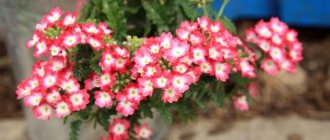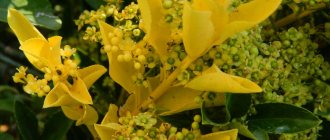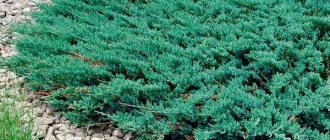Features of the view
Miscanthus is a tall perennial plant. An adult bush can reach a height of up to 2 meters. Powerful rhizomes can go into the ground to a depth of 6 meters.
The bush has grassy foliage and fan-shaped panicles, which are 10−30 cm long. The panicles have spikelets.
The plant can be used as fuel . When burned, miscanthus hay produces a lot of energy while leaving virtually no ash or ash.
Landing in the ground
Miscanthus is planted in early spring. This is a heat-loving crop, so when planting it is worth choosing a sunny place protected from the winds. A prerequisite is moist soil, so the species is suitable for edging artificial and natural country ponds.
Mostly an adult plant is planted in order to obtain the decorative properties of the crop in the first year. Young bushes take root less well, since heat-loving grass begins to develop only in warm conditions, and several months may not be enough for adaptation.
The seedling is planted in a prepared hole, the volume of which should be 30-40 cm greater than the size of the rhizome . Fertile soil is placed at the bottom of the planting hole. The seedling is dug in, gradually compacting the soil around it. After planting, the plant must be filled with plenty of water.
Planting and care in open ground
Heat-loving miscanthus is planted in open ground in the second half of spring, when the snow has completely melted and the soil has warmed up. For it, choose well-lit, open areas, protected from gusts of cold wind. The soil should be fertile and moist. It would be good if there was a fresh body of water nearby. Heavy clay soils and sandy soil are undesirable for planting miscanthus, but the proximity of groundwater and periodic flooding of the area will not harm the plant.
For small bushes, shallow holes are prepared with a distance between plants of 20-50 cm. The roots of most types of miscanthus quickly spread and occupy the adjacent territory in order to obtain compact spreading shoots and not have to worry about removing unwanted shoots in the future. Before planting, a plastic tape 25-30 cm wide is dug into the ground along the perimeter of the flower bed. Since the creeping rhizome is located close to the surface, this obstacle will become insurmountable.
The main care for miscanthus in the garden is regular watering. For example, Chinese miscanthus does not tolerate drought at all. If the plants are planted in fertile soil, then in the first year they do not need fertilizing. The following spring, the bushes are watered with complex mineral fertilizer, and in the summer - with a solution of rotted manure. The amount of nitrogen in the fertilizer should be limited, as it negatively affects the decorative effect.
As they grow, the lower part of the stems becomes bare and needs additional decoration with the help of low-growing flowering plants. It is necessary to select companions that grow normally in damp soil.
For the winter, a dried out but still beautiful bush is not cut off. It serves as protection for roots and retains snowdrifts. Heat-loving varieties are additionally covered with fallen leaves or wrapped with non-woven material. The soil at the roots can be mulched with peat or loose soil. In early spring, radical pruning is carried out. Remove the entire ground part.
Miscanthus has excellent immunity and is resistant to pests, so there is no need to protect it from germs and parasites.
Plant care
In order for the bush to always look spectacular in the garden, it is necessary to carry out the necessary care. Culture is not picky, but some rules will help achieve a decorative effect:
- Miscanthus is a moisture-loving crop. The main task of the gardener is to maintain constant soil moisture near the bush. It is especially worth monitoring this in dry weather.
- In the first year, the bush does not require feeding. From the second season, regular fertilization should be carried out. The first feeding is carried out in the spring (March-April) with liquid nitrogen-containing mixtures, for example, a urea solution. Second feeding - June - watering with humates. The third stage - August - phosphorus-potassium fertilizer.
- Loosening the soil is not required, but gardeners recommend frequent weeding.
- The plant is quite aggressive towards its neighbors, and it survives them from its territory; in addition, it is capable of growing. Therefore, it is recommended to think about restrictive barriers to the cereal growth zone before planting. These can be sheets of iron or slate; they must be deepened into the soil by at least 40 cm. Barriers should protrude 10-15 cm above the soil level. The grass has such a strong root system that it can spread far beyond the planned area.
- The plant does not respond well to transplantation. Miscanthus propagates by dividing the bush. The process is usually carried out in spring or summer.
- Reproduction is also possible by seeds. This is a long process; a bush grown in this way reaches the desired size only after 4 years. It is better to sow seeds in separate pots. It is not always possible to preserve the varietal characteristics of a plant by growing seedlings in this way.
- Miscanthus is a fairly resistant plant - it is not afraid of diseases and pests.
- Depending on the variety, the bush is covered with agrofibre for the winter and insulated. But there are also frost-resistant varieties of miscanthus; planting and care in open ground is not difficult.
Following simple rules will help even a novice gardener grow an amazing plant in his garden. In addition, the perennial will delight the owner’s eye with its luxurious vegetation for many years.
Miscanthus propagation
Miscanthus does not like changing places, but over time the shoots in the center of the bush die off, so there is a need to replant the plant, which is combined with dividing the bush - one of the most reliable vegetative methods of propagating miscanthus. The bush is divided in spring or early summer; the procedure is carried out very carefully, since miscanthus recovers after injury for a long and painful time.
It is also possible to propagate the plant by seed. Miscanthus seeds do not require pre-sowing treatment, however, the generative method of propagation will require patience from you and will take a lot of time, since a plant grown from seeds becomes attractive only in the third or fourth year. The seeds are germinated in peat pots, and with the onset of spring, after the soil has completely thawed, they are planted in open ground. We remind you that when propagated by seed, miscanthus does not retain varietal characteristics, therefore the vast majority of gardeners prefer to propagate miscanthus vegetatively.
Dividing the bush
If division is chosen for propagation of the crop, then it can be used on one bush only once every three or four years. The bush should be divided from April to June. The healthiest and most resistant specimen is selected, which is divided into the required number of parts with a sharp knife. It is important to leave a full root and 5-6 shoots for each division. The resulting miscanthuses are either immediately planted in a new place, or kept in a cool place for several days, and then moved to open ground. The depth of immersion of the division should be 6 centimeters.
Seeds
If the seeds are planted to produce seedlings, then it is worth starting the procedure in the fall. It is more convenient to use peat pots or other small containers that will only hold one or two seeds. The containers are filled with ordinary nutrient soil mixture, and the seed is deepened no more than a centimeter. Next, the plantings are irrigated, and the pots are moved to where there is good lighting. You should immediately consider creating a greenhouse using cling film or a glass sheet. As soon as shoots appear, the covering must be removed.
This is interesting: Grape varieties for the Moscow region: which one is better to grow in open ground
Until spring, seedlings should be kept at a temperature of 20 degrees Celsius. To create the required duration of daylight hours, it is better to use special lamps. Watering should be regular, but carried out only when the earthen ball dries out, that is, you should focus on the current state of the soil. Planting in open ground is carried out when warm weather sets in, and there is no need to fear the return of frost. The plants will first need to be hardened off by taking them outside for a period of 2 hours to the whole night.
It is worth noting that the seed propagation method is not particularly effective. Seed material is quite difficult to collect due to its miniature size, and decorative characteristics in most cases disappear. In addition, for the bush to develop to a good size, you will have to wait 3 to 4 years.
Description of the plant
Miscanthus is a perennial grass with a short rhizome, straight stems, the bottom of which is covered with long, rough leaves 2 cm wide. The height of the plant, depending on the species, can vary and reach a height of more than 2 meters. The hard surface of the cereal varies in color. A distinctive feature of Chinese reeds are single-colored spikelets placed on loose and short fan-shaped panicles. A huge number of miscanthus varieties are growing all over the world, but not many have taken root in Russia, as they cannot withstand frost.
Types and varieties of miscanthus with photos and names
Miscanthus, due to its spreading leaves, is also known by another name - fan.
Its creeping roots are capable of penetrating deep into the soil up to 6 m. The bush has erect stems.
Fanflower leaves are long, with leathery plates. Their width is only 0.5-1.5 cm.
Depending on the miscanthus variety, the leaves are green, brown, bronze, pink, and silver.
Flowering begins in July and lasts until autumn. At this time, inflorescences of silver, red, pink, and yellow colors are formed.
Miscanthus is an unpretentious crop; caring for it is very simple.
Landowners are increasingly choosing fan grass.
This plant makes a wonderful and original addition to any site.
The bush grows from approximately 80 to 300 cm. The height of the plant depends on the variety and growing conditions.
Miscanthus giganteus is considered the most colorful of all known species. This species can reach a height of 3 m. The leaves of the giant miscanthus are green with a white streak in the middle. Flowering begins closer to autumn, when pink flowers are formed. Over time, the panicle changes color from pink to silver. Chinese miscanthus (miscanthus sinensis) Can be found in Korea, China and Russia. The height of the stems reaches 3 m. The leaves are yellow, with a silvery core. The color of the inflorescences depends on the specific plant variety.
The most popular are the spectacular varieties, including:
Chinese Miscanthus Flamingo - the name of the variety is associated with the shades of pink inflorescences, the height of the plant stems is 2 m. Miscanthus Strictus - is distinguished by unusual leaves. They have a variegated color. The flowers are red, the height of the stems of Miscanthus Strictus is about 250-270 cm Maleparthus is an early species, blooms early, with red flowers. Variegatus is a lower plant, up to 150 cm tall, with red inflorescences and leaves with white stripes. Miscanthus Zebrina is a variety with variegated leaves that have yellow transverse stripes Ferner Austin - with green leaves with white stripes. With the onset of autumn, the leaves turn a reddish-red hue. The inflorescences are red, changing color to bronze and silver. Morning Light - a distinctive feature of the variety is that this bush does not bloom every year. Its leaves are green with a white border. Miscanthus sacchariflorus loves warmth most of all. The bush grows up to 2 m tall. It has green leaves and silvery inflorescences. Blooms from mid-summer to autumn.
Soil Features
For miscanthus, the composition of the soil does not play a big role, but it is not recommended to plant it on clay. If you pay attention to the acidity of the soil, then it should be neutral or slightly acidic in composition.
Planting and care in open ground
The cereal must be planted in the spring, but only when the soil is well warmed up, otherwise the cereal will not take root. It is better to plant it when the weather has been sunny outside for several days. Miscanthus loves warmth very much, so it is necessary to choose a place that is warm and protected from gusts of cold wind. A plant cannot grow well if it is not provided with moisture. Therefore, nutritious, moist soil would be preferable for cereals.
Important! If Chinese miscanthus is planted on clay or sand, the plant will grow and develop poorly.
It is better to plant an adult seedling, since it will be difficult for a young one to take root and prepare for the cold. An adult tolerates cold well, but he must be well covered, providing him with plenty of warmth. For planting, a hole is dug in the ground. It should be slightly larger than the size of the plant's root system. After the hole is made, it is necessary to fill it with nutritious soil and only then the seedling is placed. The hole is filled in so that there are no voids, everything should be tightly covered. The next step is to water the plant abundantly.
In order for Chinese miscanthus to grow well, it is necessary to provide it with proper planting and care.
Miscanthus is a moisture-loving cereal plant, so it needs timely watering so that it does not dry out. If the weather is hot without rain, miscanthus is watered from a hose with good pressure. Like any plant, miscanthus requires feeding, but it must be moderate so that the plant does not die.
Advice! After the plant is planted, it is not fed for 12 months so as not to destroy it.
After the May holidays, you can feed them with nitrogen-containing fertilizer. After the first half of June, cereals are watered with humates; in August they need to be fed with phosphorus-potassium fertilizers. In order for the plant to become stronger and grow well, it is necessary to devote enough time to weeding in the first two years. No loosening of the soil is required.
Important! If you weed the plant well for two years, the weeds will stop growing.
Miscanthus can destroy plants that grow in the neighborhood. Therefore, to prevent this from happening, it is necessary to protect it. Fencing devices are dug 20 cm deep, and their height above the ground should be 10 cm. Other methods can also be used.
Miscanthus - planting and care in open ground
When breeding a plant such as fantail, you should first become familiar with its characteristics. So, the gardener needs to remember that miscanthus is a fairly heat-loving plant that loves high humidity. Therefore, it is best to give it a place where there is the most light and a body of water nearby.
As already mentioned, fan grass can be planted in open ground. Caring for it is quite simple. Initially, it is necessary to purchase adult seedlings. Their growing season is quite long, and plant growth begins completely when the air temperature warms up to 25 degrees Celsius. After planting, the plant should be watered abundantly.
Miscanthus will also like fertile soils. And in the spring, it is best to fertilize the soil under miscanthus. For a positive effect, one feeding per year will be enough, since an excess is harmful. Miscanthus does not like dry soil, so it needs to be watered frequently. There is no need to cover the plant for the winter, except for very heat-loving species. It is best to mulch the soil.
Caring for a fan is quite simple; no special skills or abilities are required. All you need is desire. It must be taken into account that roots can grow not only into the ground, but also above the soil. Leaves and shoots will fall off in winter, and pruning will be required in spring. The plant is cut back almost to ground level in March.
Miscanthus stems are as good as pine needles or straw. Therefore, you can mulch the soil with dried and chopped fantail stems.
It is better to water the vernik with a hose; the more often you water, the better. In the first few years, it is necessary to control weeds. But after the plant gets stronger, the weeds will not be able to get through the thick fan.
It is best to limit the growth of the fan after planting, since it can grow throughout the garden. You can limit the size of the fan with iron or slate. The limiters must be buried in the ground to a depth of about 20 cm and at least 10 cm must remain on the surface. Only under this condition will the fan plant allow other plants to grow calmly and its roots will not be able to penetrate the iron.
It is more rational to plant a hosta next to the miscanthus, which will grow well in moist soil and reach up to 60 cm in length. This is necessary in order to disguise the loss of the lower leaves of the fan. Because by the end of summer it is capable of losing its leaves.
There are very delicate varieties of this plant that need to be covered for the winter, since unexpected frosts can destroy the plant. It is recommended to cover with film, while ensuring the passage of air from the sides. Before sheltering, you should mulch the soil under the miscanthus. Having completed such events, miscanthus will continue to please its owner next year.
Any gardener who decides to grow a fan garden will ask himself: what flowers or plants are best to plant in the neighborhood. It can be:
Reproduction of fanweed
Adult fantail is propagated by dividing the rhizome. This procedure must be carried out very carefully in the spring. When planting fan grass, the air temperature should be more than 20 degrees Celsius, otherwise the plant will take root very slowly.
Before planting, you need to dig a hole so that the rhizome is covered with a 5 cm layer of soil. In this case, the soil should not be compacted too much. Around mid-July, the plant takes root and begins to grow.
It is also possible to grow miscanthus by seed. But this method is not as popular as dividing the bush. This is due to the fact that when grown from seed, the plant becomes decorative only three years after planting. In this case, the seeds need to be bought in the store, because in our climate the fantail does not produce seeds.
Since the seed propagation method takes quite a long time, propagation by dividing the rhizome is the most popular among gardeners.
Fantail can be fed. Compost or liquid chicken manure is suitable as fertilizing. But it is necessary to feed the fantail one year after planting it. Closer to the autumn period, it is recommended to feed with potassium-phosphorus supplements.
As already mentioned, fan grass is an ornamental plant that gardeners use for various purposes. It could be:
- Coastal decoration;
- Shading of plantings;
- For framing flower beds;
- Creation of landscape compositions.
On the Internet you can find many reviews and comments about the cultivation and flowering of fan grass. There you can learn some knowledge and secrets of other gardeners.
Miscanthus varieties
Miscanthus are divided into several types according to their height:
- Low-growing - the usual height is no more than 1.5 m. The leaves of this species are thin, mainly such miscanthuses are placed in front of the flower bed.
- Medium-sized - the height of the bush is no more than 1.8 m, planted in the garden in small groups.
- Tall - the height of the grass is more than 2 m. This species mainly grows in warm climates.
Today there are more than a hundred varieties of Chinese miscanthus (Malepartus, Gracilimus and others). Each has its own characteristics. The color of plant inflorescences can be varied - white, pink, brown, with shades of burgundy. Each variety has different leaves in shape and size. The main difference between the varieties is the size and shape of the bush.
For the Moscow region
The most proven variety for the Moscow region is miscanthus “Silberfeder” (photo). The plant has two centimeter green leaves. The pinkish flowers can be compared to feathers. In August, green arrows begin to appear.
The following varieties will also grow well in the Moscow region:
- Blondeau;
- Flamingo;
- Gracilimus;
- Grosse Fontane;
- Hinjo;
- Kleine Fontane;
- Maleparthus;
- Morning Light;
- Nippon, Rotsilber;
- Silberfeder;
- Strictus;
- Variegatus;
- Zebrinus.
Morning light
This is an amazingly beautiful variety of Chinese miscanthus; in the photo you can see its peculiarity - the leaf blades have white margins. If you look at the plant at the moment when the rays of the sun fall on it, you might think that it is covered with frost. In appearance, the reed resembles a lush boulder. When the barren inflorescences bloom, they become an amazing crimson-red hue, and when they ripen, they turn brown, but this does not lose their beauty and uniqueness.
Morning light blooms from late summer to late autumn. It can be planted over a large area or in a separate container. The height of the plant reaches 1.5 meters. Morning light loves moisture and sun, and is not picky about the soil.
Miscanthus chinensis, varieties:
"Flamingo" - the height of the variety in favorable conditions is about 2 m, the leaves are up to 1 cm wide, the inflorescences are pink, drooping, blooms at the end of August.
"Klein Silberspine"
"Kleine Silberspinne" - in the Moscow region, about 1.5 m tall, narrow leaves up to 1 cm wide, silvery erect panicles, blooms in early September.
"Malepartus"
"Malepartus" - variety 1.5 - 2 m tall, leaves about 1.5 cm wide, golden-orange in autumn, inflorescences first dark pinkish, then white, lush and numerous, blooms in early September.
"Morning Light"
"Morning Light" - a plant up to 1.5 m tall, leaves about 6 mm wide with thin pure white stripes along the edge of the leaf, reddish-pink panicles, blooms at the end of September.
"Saraband"
"Sarabande" - the height of the grass can reach 2 m, but it grows slowly, the leaves are about 5 mm wide, from the end of summer they begin to acquire reddish shades, the inflorescences are creamy-white, it blooms in August.
"Silberfeder"
"Silberfeder" - a variety about 2 m tall, leaves up to 2 cm wide, slightly drooping stems, large fluffy panicles, pinkish-silver, blooms in August.
Location:
Miscanthus chinensis loves warm sunny places and can grow in shade, but does not bloom.
Any soil, except sand, is nutritious and moisture-absorbing. Tolerates waterlogging well.
For better overwintering of Chinese miscanthus in the middle zone, several conditions must be met:
- you need to buy the plant in the spring and in large divisions so that it can take root well before the cold weather,
- In the spring, it is necessary to feed the grain with organic fertilizers (humus, compost), or better yet, water it with liquid organic matter (infused bird droppings, manure) or humate. Instead of organic matter, you can add complex mineral fertilizer. This is important for a quick start of the plant in our short growing season, miscanthus
- In summer, the soil should not dry out too much, so abundant watering (a bucket per plant) is necessary.
- In the fall, the stems and leaves are not cut , leaving this work until spring. In spring, this can be done in April - early May, since miscanthus begins to grow quite late. Leaves left in the winter will help the plant to overwinter better by additionally covering the roots. In the first winters, it is necessary to cover the root zone under the grass with a 5 cm layer of humus, leaves or sphagnum.
Add a comment Cancel reply
This site uses Akismet to reduce spam. Find out how your comment data is processed.
Description of the flower
Miscanthus, or fan (from the Latin Miscanthus) is a perennial plant of the Poaceae family. The height of the bush depends on the variety and ranges from 0.8 to 3 m. The stems are straight and strong. The hard leaf blades, 0.5-1.8 cm wide, have a leathery texture with scales. The inflorescences are fan-shaped panicles 10-30 cm long with spikelets 0.3-0.7 cm.
Flowering fan
For your information! There are about 40 species of fanweed in the world. However, not all are used in gardening.
Most are wild, found throughout Russia. The most common types are the following:
- Miscanthus sugarflower is a perennial with a developed root system. The grass reaches a height of no more than 2 m. The leaves are hard and broad-linear. Miscanthus sugarflower begins to bloom in August with fan-shaped panicles 30 cm long;
- Miscanthus giant got its name thanks to its straight stems, reaching a height of 3 m. The leaves are narrow, hard, dark green in color with a light stripe in the middle. This is a frost-resistant species that can withstand temperatures down to −34 °C. Pink panicle flowers become silvery over time;
- Chinese miscanthus has high frost resistance. This type of perennial has a short rhizome, the height of the stem reaches 3 m. The scaly leaves, 1.5 cm wide, acquire a red-yellow hue by autumn. It blooms from August to October with pink and silvery spikelets.
Miscanthus chinensis Gracilimus is the most popular and favorite variety among gardeners; it will rightfully become a highlight in any area
Chinese miscanthus, or Chinese reed (Miscanthus sinensis) has many varieties. Below are the names and descriptions of the most famous ones:
- Miscanthus Purpurescens. The height of the stems is no more than 1.5 m. The gray-green leaves change color to red-orange in autumn. At the beginning of autumn, the narrow spikelets are colored purple. Over the course of two months, the inflorescences gradually change color to white;
- Miscanthus Morning Light. Light-loving variety up to 2 m in height. The bush has narrow leaves with white stripes along the edges and blooms in late September with reddish clusters;
- Miscanthus Little Zebra. A low-growing bush up to 1.2 m in height with leaves painted to resemble an African animal: green transverse stripes alternating with yellow. The red-violet inflorescences turn cream by October;
- Miscanthus Gracilimus. A shade-loving plant, more than 2 m high. It has a spherical shape of thin leaves of a weeping appearance. It blooms in July with small spikelets of purple-silver color;
- Miscanthus Flamingo. The variety got its name in honor of the large flowers in the shade of a pink bird. The height of the flower is about 2 m. Frost-resistant, does not require insulation for the winter;
- Miscanthus Strictus. Not picky about soil. In dry areas the bush reaches a height of 2 m, in more humid areas - 3 m. The leaves have a transverse stripe, changing green to white. Inflorescences appear in the first month of autumn in the form of pale red spikelets;
- Miscanthus Goliath. Bush 2-2.7 m high and 1.5 m wide with wide leaves. It blooms from August to October with fluffy silver panicles. The place for growing requires a sunny place and is not picky about soil.
Biological description of miscanthus
The grass is a perennial that grows up to two meters. The root system of miscanthus is quite deep and extends up to six meters. The perennial has straight stems with scaly leaves. The stems end in long panicles with spikelets. In its natural environment, fantail grows in tropical warm climates, for example, on the mainland of Australia and Africa.
The perennial plant is hardy. It is non-poisonous and non-toxic to humans and animals. Miscanthus is used as fuel for power plants. Burnt plant materials produce little ash, but a lot of energy. The seemingly lush green leaves contain very little water. In autumn, they turn yellow or acquire brown and bronze shades. The spreading panicles have a pink tint from the beginning of flowering, and then acquire an unusual silver color. The plant blooms from mid-June or August. Flowering time may shift if summer is cold. Miscanthus does not require much care and is not difficult to grow in the garden. Many florists like to use this plant to decorate cottages and gardens.
This is interesting: How to plant and grow a chestnut from a nut - features of growing
In addition to beauty, Miscanthus has a number of other useful properties that are used in practical human activities, for example, fuel for power plants. But at the same time, the unruly grass behaves like a weed and is capable of displacing other plants from the site. Miscanthus bushes quickly grow in width and occupy more and more new territories. To prevent the plant's roots from spreading so quickly, gardeners dig sheets of iron or slate around the perimeter of the site to a depth of at least 30 centimeters. The obstacle for the plant should rise above the ground at least ten centimeters.











